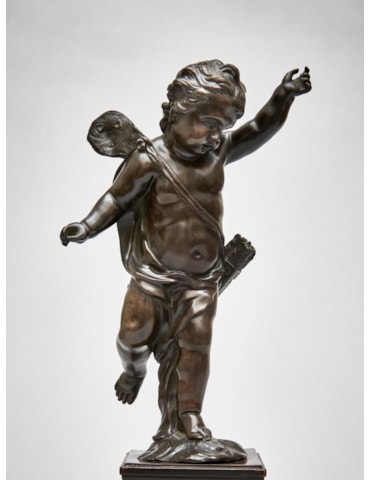Giovanni Battista Polidoro
A Processional Bust of a Female Saint
Lime-wood, with original polychrome, and glass over the painted eyes
Height: 33 cm / 13 in
Height: 33 cm / 13 in
ENQUIRIES
+44 (0)20 7259 0707
Facture: Carved out of a single piece of lime-wood, the head retains its original polychrome, beneath which a ground of gesso was applied directly to the surface of the work. The eyes are painted and faced with glass, which is cracked on her left side. The holes cut low in the centre of the bust (one in the front and three in the back) are original, and would have been used to attach processional drapery. A hole in the back of the head may have supported a halo.
The very fine quality of carving and painting of the present figure-head is quite exceptional for the standards of such processional sculptures. On the occasion of the appropriate Saint’s or Feast Day, these figures were attired in robes and paraded through the streets of the town in a great liturgical procession. The ensemble would have been held high on a pole located within the bust in the circular void that extends up through the neck. The carving and polychrome of the present Bust of a Female Saint closely resemble the Angel of the Annunciation in the Museo Nazionale di San Martino, Naples, which is given to Polidoro by Elio Catello.1 The Naples figure demonstrates how the carved head, chest and limbs of these presepe figures were sewn into drapery and built up around mannequin bodies. It is also characteristic of Neapolitan and Spanish wood sculpture of this period that glass has been used to give a life-like gleam to the eyes. Either the eyes consisted of solid glass, or a lens was applied over the painted wooden surface, as in the case of the present bust. Polidoro is known primarily as a model-maker at the royal porcelain manufactory in Naples. He was taken on as a modeller in 1781 and was still working there in 1802. Only now is Polidoro emerging as a sculptor outside this domain.2
1. E. Catello, Civiltà del presepe a Napoli, Naples, 1999, pp. 34-35.
2. For a brief biographical account of Polidoro, see Catello 1999, p. 165.
The very fine quality of carving and painting of the present figure-head is quite exceptional for the standards of such processional sculptures. On the occasion of the appropriate Saint’s or Feast Day, these figures were attired in robes and paraded through the streets of the town in a great liturgical procession. The ensemble would have been held high on a pole located within the bust in the circular void that extends up through the neck. The carving and polychrome of the present Bust of a Female Saint closely resemble the Angel of the Annunciation in the Museo Nazionale di San Martino, Naples, which is given to Polidoro by Elio Catello.1 The Naples figure demonstrates how the carved head, chest and limbs of these presepe figures were sewn into drapery and built up around mannequin bodies. It is also characteristic of Neapolitan and Spanish wood sculpture of this period that glass has been used to give a life-like gleam to the eyes. Either the eyes consisted of solid glass, or a lens was applied over the painted wooden surface, as in the case of the present bust. Polidoro is known primarily as a model-maker at the royal porcelain manufactory in Naples. He was taken on as a modeller in 1781 and was still working there in 1802. Only now is Polidoro emerging as a sculptor outside this domain.2
1. E. Catello, Civiltà del presepe a Napoli, Naples, 1999, pp. 34-35.
2. For a brief biographical account of Polidoro, see Catello 1999, p. 165.





